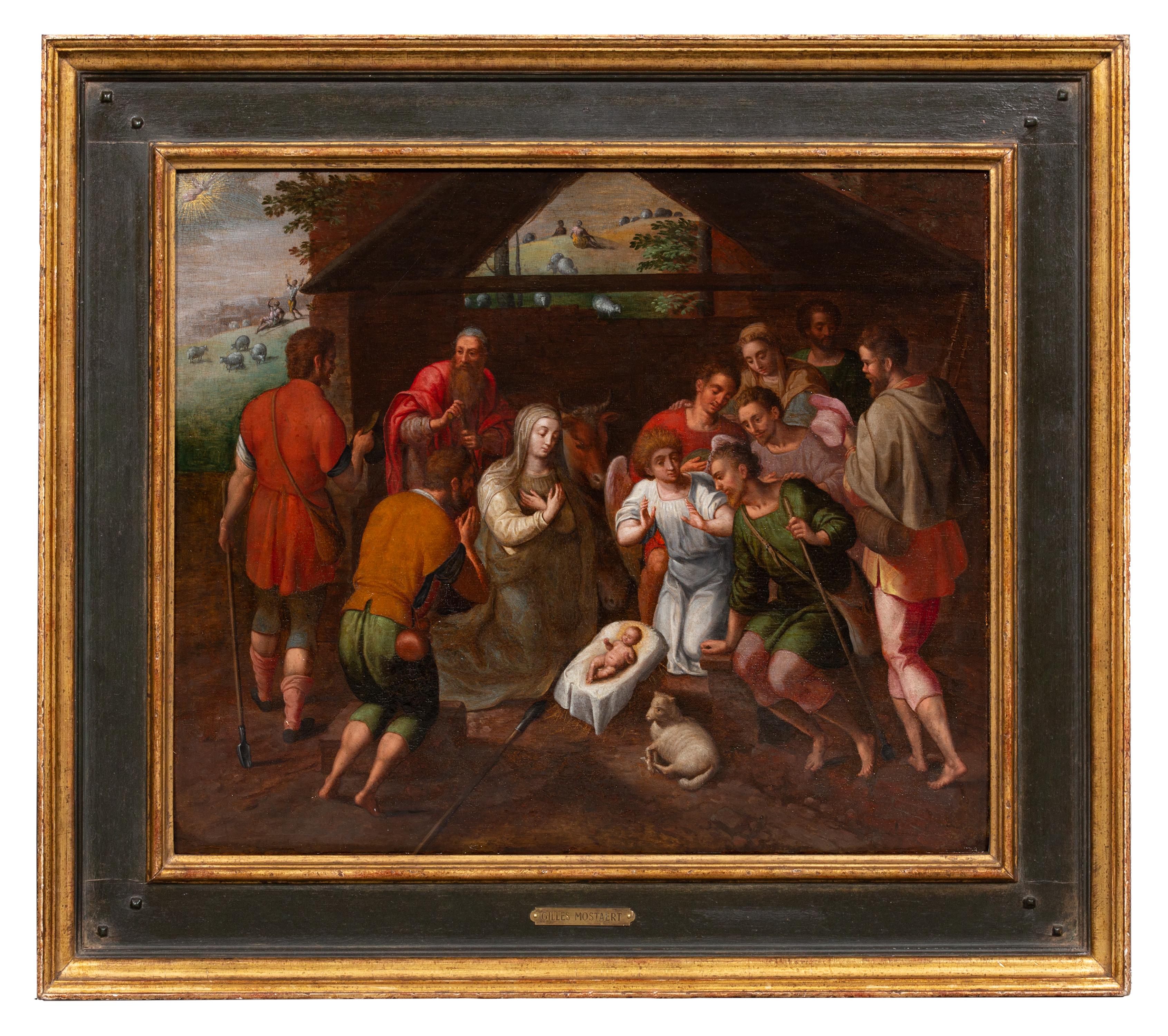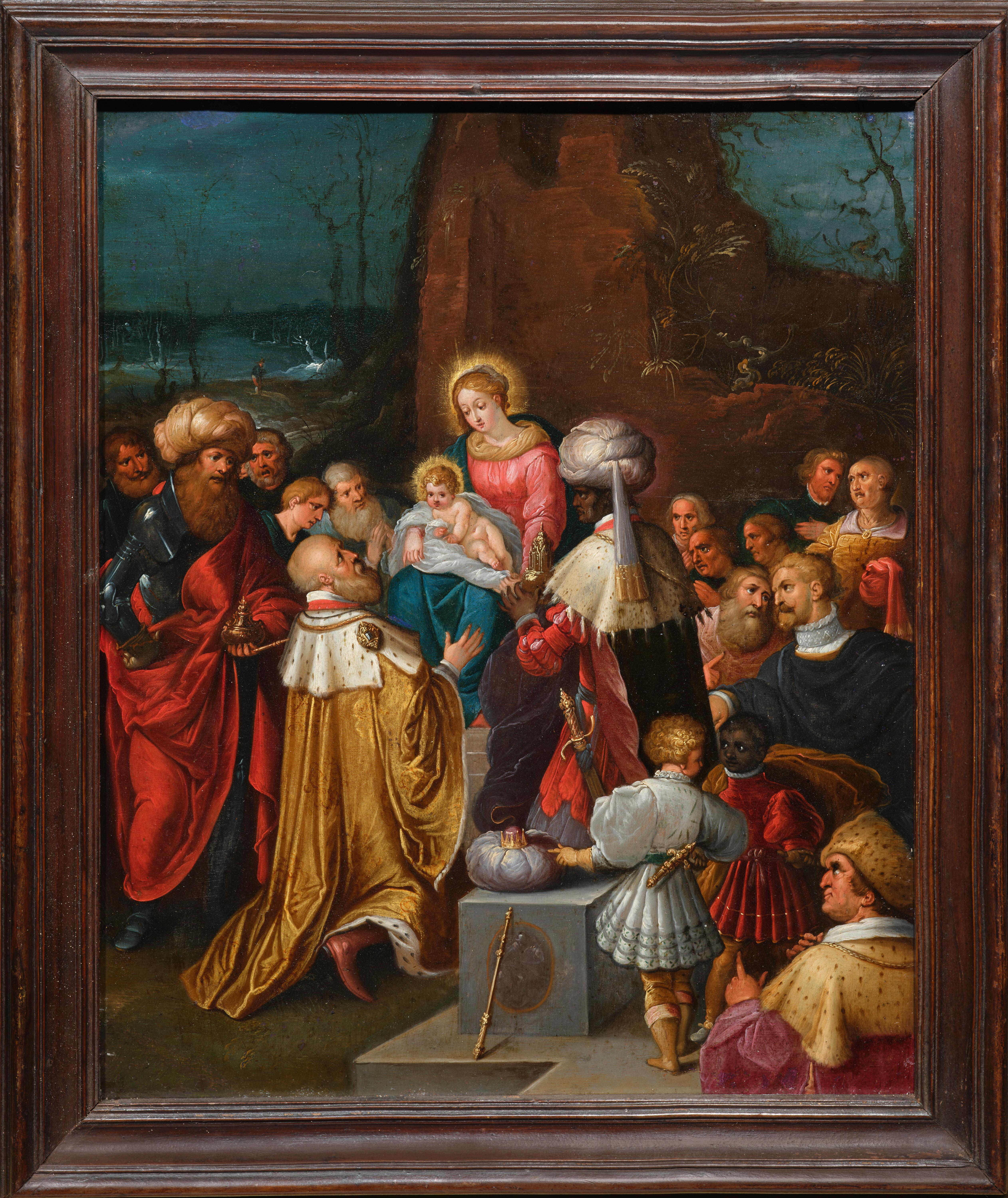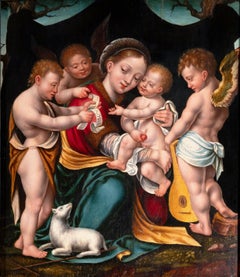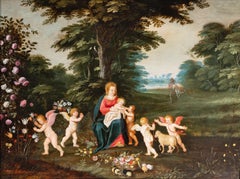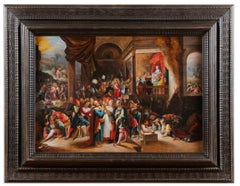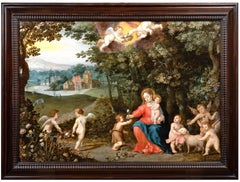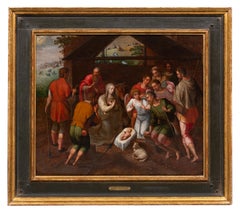Items Similar to Cercle of Ambrosius Francken, Adoration of the shepherds, 17th century Antwerp
Want more images or videos?
Request additional images or videos from the seller
1 of 15
Cercle of Ambrosius Francken, Adoration of the shepherds, 17th century Antwerp1600
1600
$34,383.51
£25,603.07
€29,000
CA$47,244.84
A$52,875.86
CHF 27,597.14
MX$644,812.96
NOK 353,205.79
SEK 334,354.51
DKK 220,751.62
Shipping
Retrieving quote...The 1stDibs Promise:
Authenticity Guarantee,
Money-Back Guarantee,
24-Hour Cancellation
About the Item
Adoration of the shepherds,
Cercle of Ambrosius Francken,
Early 17th century Antwerp school
Oil on oak panel: h. 55 cm, w. 43 cm (21.65 in x 16.93 in)
17th c. ebonized and moulded frame
Framed : h. 100 cm, w. 83 cm
Provenance: collection of Barons of Schrenck-Notzing, Munich, Bavaria, then by descent
Relating an episode in the life of Christ, our painting superimposes the Adoration of the Shepherds with the Announcement to the Shepherds in the background and illustrates a group of characters gathered in the stable around the child Jesus.
The vertical format compresses the composition by bringing the characters together and pushing them partially out of the frame. Some whose faces or even parts of faces are barely visible accentuate the density of the group. The painter places in the center the improvised cradle of the child Jesus whose white fabrics are transformed into a large point of light and draws the eye towards the center. The figures are placed on several registers: in the foreground more monumental figures with muscular and powerful bodies then smaller characters in the second and third planes. Joseph makes a separate figure with the movement of his body obliquely, he spreads himself on the donkey, pushed and embarrassed by the crowd, almost a stranger to the scene. The strongly accentuated gesture creates movement and dynamism: between the outstretched arms with open hands, the hands joined in prayer, the hands pointing the index finger towards the sky. The tumult of the scene is thus transmitted through this body language.
The palette of bright and tangy colors enchants with its pink and purplish shades, bottle greens, powerful reds, yellow ochres, oranges with golden reflections. The painter sculpts draperies of his overdressed figures with glistening crests and vibrant material from the fabrics. The sunburned male faces are executed in brown-toned ochres and appear backlit with very little lighting and in the shadows of hats. They contrast with the whiteness of Marie's skin tones.
Her illuminated face with half-closed eyes is dominated by her straight nose with a prominent tip. This feature of physiognomy appears frequently in the female faces of Ambrosius Francken (the Virgin in "The Three Marys",
Bar-sur-Seine, Saint-Etienne church; a woman in “Let the little children come to me”, private collection; a woman in “The Lamentation of Christ” at the Royal Museum of Fine Arts Antwerp)
We find her characteristic hairline is also identical to that found in the works of Ambrosius Francken.
We frequently observe in Ambrosius Francken paintings robust and muscular male and female figures in the foreground seen from behind. This inclination for antique and Italian Renaissance models was certainly transmitted by Frans Floris. These spinal twists visible or suggested by tight-fitting fabrics are naturally associated with ancient heroes.
It is thus appropriate to compare the woman seen from the back of our painting with the figures in the works of Ambrosius Francken (a woman in The Judgment of Zaleucus at the Fitzwilliam Museum, Cambridge; the executioner in Decapitation of Saint George, Royal Museum of Fine Arts, Antwerp).
If the composition and stylistic points of convergence point strongly to the works of Ambrosius Francken ("Let the little children come to me"
Private collection, "Les Trois Maries" in Bar-sur-Seine, Saint-Etienne church), our artist's brush seems more vibrant and nervous. Instead of smoothing the material, the painter superimposes very light and rapid brushstrokes without repentance to create texture and depth in the composition. His quick, but delicate and graceful strokes testify to great skill and perfect mastery of drawing, but also of light effects, virtuosity in the rendering of reflections.
Considering the number of painters in the Francken family, it seems judicious to attribute our painting to the direct entourage of Ambrosius Francken and probably to an artist from his family workshop or even a member of his family.
- Creation Year:1600
- Dimensions:Height: 39.37 in (100 cm)Width: 32.68 in (83.01 cm)
- Medium:
- Movement & Style:
- Circle Of:Ambrosius Francken (1544 - 1618, Flemish)
- Period:Early 17th Century
- Condition:professionally cleaned, revarnished and ready to be hunged on the wall.
- Gallery Location:PARIS, FR
- Reference Number:1stDibs: LU2433214027282
About the Seller
No Reviews Yet
Vetted Professional Seller
Every seller passes strict standards for authenticity and reliability
1stDibs seller since 2023
16 sales on 1stDibs
- ShippingRetrieving quote...Shipping from: PARIS, France
- Return Policy
Authenticity Guarantee
In the unlikely event there’s an issue with an item’s authenticity, contact us within 1 year for a full refund. DetailsMoney-Back Guarantee
If your item is not as described, is damaged in transit, or does not arrive, contact us within 7 days for a full refund. Details24-Hour Cancellation
You have a 24-hour grace period in which to reconsider your purchase, with no questions asked.Vetted Professional Sellers
Our world-class sellers must adhere to strict standards for service and quality, maintaining the integrity of our listings.Price-Match Guarantee
If you find that a seller listed the same item for a lower price elsewhere, we’ll match it.Trusted Global Delivery
Our best-in-class carrier network provides specialized shipping options worldwide, including custom delivery.More From This Seller
View AllMadonna and child with angels, circle of Joos Van Cleve, 16th c. Antwerp school
By Joos van Cleve
Located in PARIS, FR
Madonna and Child with Saint John the Baptist and angels
Circle of Joos Van Cleve (1485 – 1541)
16th century Antwerp school
Oil on oak panel
Dimensions: h. 32 cm (13 in.), w. 28.5 cm...
Category
16th Century Old Masters Figurative Paintings
Materials
Oak, Oil
Rest on the Flight into Egypt - Attributed to Pieter Van Avont - 17th c. Flemish
By Pieter van Avont
Located in PARIS, FR
Rest during the Flight into Egypt - The Virgin and Child with St. John the Baptist and the angels in a Landscape.
Attributed to Pieter Van Avont (1600-1652)
17th century Antwerp School, circa 1630
Oil on oak panel,
Dimensions: h. 38 cm, w. 50 cm (14.96 in x 19.68 in)
Flemish style frame in ebonized and moulded wood
Framed: h. 56 cm, w. 68.5 cm (22.04 in. x 26.97 in.)
In the heart of a lush wooded landscape, the Virgin with Jesus rests in a green clearing accompanied by Saint John the Baptist and the cherubs. Seated to the left of the composition, the Virgin Mary holds the Child on her lap; the little Saint John the Baptist wearing the camel-skin tunic (his attribute) stands before Jesus to exchange a few caresses. On the right, the couple of cherubs are playing with the lamb of Saint John the Baptist, bringing a jovial character to the scene. A pair of gardening putti on the left pick flowers to bring bouquets to the Virgin and Jesus. Spring flowers such as tulips, daffodils and anemones that grow abundantly around them and enrich the composition with their shimmering colors. A lush rose bush blooms to the left of the figures offering delicate roses. (The rose is the flower associated with the Virgin Mary, who is the "mystical rose," the one that does not bear the "thorn of sin")
At the feet of the Virgin are bunches of grapes (symbol of the future passion of Christ) as well as apples (symbol of the original fall of Man but also of the Redemption in Christ) In the foreground we find a wicker basket filled in profusion with beautiful flowers and guinea pigs nibbling on the blades of grass. In a cleverly arranged disorder, these elements of the still life with their strong symbolic power accentuate the religious theme, but are also an opportunity for the artist to demonstrate his know-how in the still life genre that is gaining momentum in Antwerp. The landscape behind the figures consists of a large tree with a twisted trunk and a luminous opening to the horizon placed on the right. We see Saint Joseph arriving with a donkey, a small reminder from the artist that the composition is associated with the episode of Rest during the flight into Egypt.
The calm expanse of this bucolic forest opening onto the luminous distance, with its profusion of symbolic flowers and fruits, is particularly suited to this sacred scene. The theme of Jesus' sacrifice and his tragic fate is mitigated by cherubs who play with innocence and carelessness in the face of the fragility of life symbolized by cut flowers. The great mastery of the painter is manifested by the finesse of the drawing enhanced by the delicacy in the application of the brushstrokes bringing a multitude of details. The richness of the whole is exacerbated thanks to the choice of colours, this varied palette is an undeniable asset of our work.
The virtuosity of our artist lies in his versatility, as much concerned with the success of the landscape and flowers as with the modelling of his figures. The cherubs with their naked bodies are gracefully illuminated by warm colours with subtle shadows, while the still life is rendered with astonishing realism, both in the precision of the drawing and in the countless shades of the flowers.
There are several compositions similar to ours, of which below are the closest versions:
• Sale, Jean-Claude Anaf et Associés, Lyon, 08/02/1998, attributed to Pieter Van Avont, oil on panel, h. 48 cm, l. 71 cm (recorded on RKD n° 31451). Comment: identical composition, only St Joseph with the donkey is different)
• Christie's New York sale, 29/01/1998, Pieter Van Avont, oil on copper, h. 23.8 cm, w. 24.8 cm
• Dorotheum sale, Vienna, 25/04/2017, Pieter Van Avont and Jan Breughel II, oil on copper, h .26 cm, w. 39 cm
• Hermitage Museum, Saint Petersburg, Russia, Pieter Van Avont, oil on panel, h. 50.5 cm, w. 71.7 cm
Peter van Avont, Flemish painter (Mechelen, 1600 - Antwerp. 1652)
Born in Mechelen, he is mentioned in 1620 as a member of the painters' guild of his hometown. He left in 1 622 for Antwerp, where he was also a member of the guild. He collaborated with many painters, including Jan Brueguel the Younger, David Vinckboons, Lucas van Uden...
Category
17th Century Old Masters Landscape Paintings
Materials
Oak, Oil
Hieronymus FRANCKEN III - The Denial of Saint Peter, 17th c. Antwerp school
Located in PARIS, FR
Hieronymus FRANCKEN III (Antwerp 1611 - 1671)
17th century Antwerp School
The Denial of Saint Peter
Oil on panel, dim. h. 53 cm, l. 76 cm
Framed, h. 82 cm, l. 106 cm
Sold with the ...
Category
Mid-17th Century Old Masters Figurative Paintings
Materials
Oil, Wood Panel
17th c. Antwerp studio of J. Brueghel & H. van Balen - The Virgin with Child
Located in PARIS, FR
Workshop of Jan Brueghel the Younger (1601-1678) & Hendrick van Balen (Antwerp, 1575 – 1632)
17th century Antwerp School
The Virgin and Child ...
Category
1630s Old Masters Figurative Paintings
Materials
Oil
The Triumph of the Infant Bacchus, workshop of H. Van Balen, 16th c. Antwerp
By Hendrick van Balen
Located in PARIS, FR
The Triumph of the Infant Bacchus,
Workshop of Hendrick Van Balen (1575-1632)
Antwerp, c.1630
Oil on copper, h. 28 cm (11.02 in), w. 35 cm (13.78 in)
A large Roman 17th century golden painted frame
Framed: h. 52 cm (20.47 in.), w. 58 cm (22.83 in)
Our finely painted work depicts The Triumph of the Bacchus as a young boy and is one of the most popular mythological subjects in Antwerp at the beginning of the 17th century. Feasting, wine and fun are the themes that constantly appeal to the public.
Thus unfolds before our eyes on our painting the procession composed of nymphs, baccantes, fauns, satyrs and children, their bodies naked, partially covered with brightly coloured draperies that help to brighten up the parade. Playing various instruments, dancing and drinking, while carrying vases and poles adorned with grapevines, participants to the rhythm of a noisy brass band make their way to an ancient temple standing on the right. The exaggerated gestures convey to us the frenzy of the excited crowd.
The Child Bacchus follows the joyous procession, carried by satyrs and nymphs, crowned with ivy and joyfully raising a cup of wine. In the foreground, the drunken participants leave the procession, the children on the left and the group of bacchantes and satyrs on the right are resting among various objects scattered at their feet: cups, vases, ewers bear witness to the festivities in progress.
In the background, a hilly landscape stretches out on the horizon, a semblance of calm that contrasts with the bustle of the foreground.
The artist strives to multiply the many details, whether it be figures, costumes, flowers or vegetation, in order to demonstrate his know-how and the perfection of his execution.
The acidulous palette with fresh and varied colours is characteristic of Hendrick Van Balen's works.
There are several versions identical to ours with similar dimensions painted by Hendrick Van Balen and his workshop.
Related works:
• Koller Auction, Zurich, 21/09/2007, oil on copper, 28,5 x 37,4 cm.
• Staatliche Kunsthalle, Karlsruhe, Inv. N° 809 (oil on copper, 40 x 53,5 cm)
• Auktionshaus für Altertümer Glückselig, Vienne, 10/05/1932, ( oil on copper, 34 x 42 cm)
• Gemäldegalerie of Pommersfelden, Schloss Weissenstein, oil on panel, 47 x 64 cm
Hendrick Van Balen, Flemish painter, born and died in Antwerp (1575-1632). A pupil of Adam Van Noort, he entered the Guild of St. Luke in 1593, later trained in Italy and was Van Dyck's first teacher. He often painted small figures taken from scenes from the Bible or classical mythology, on paintings whose backgrounds and landscapes were painted by Josse de Momper...
Category
17th Century Old Masters Figurative Paintings
Materials
Copper
Attributed à H. Francken II, 17th c. Anwerp - The prodigal son among courtesans
Located in PARIS, FR
The Prodigal Son Among Courtesans
Attributed to Hieronymus Francken II (Antwerp 1578-1623)
Early 17th century Antwerp school
Oil on oak panel,
Dimensions: H. 52.5 cm (20.67 in), W. 74 cm (29.14 in)
Flemish-style moulded wood frame
Frame: h. 78 cm (h. 30.70 in.), w. 100 cm (39.37 in.)
At first glance, this festive and joyful painting depicts a group of elegantly dressed people dancing to the sound of an orchestra in a richly decorated interior with a wide opening onto a rural exterior. However, the real theme is cleverly concealed by the painter and is only discernible through the artifice of a small scene in the background where we see a half-naked man, in the company of the pigs next to a makeshift shelter.
In fact, beyond the pleasant and apparently superficial character of the painting, it is a subject taken from the parable of the prodigal son in the Gospel. The illustrated episode is the prodigal son among courtesans.
Even if the viewer's attention is drawn to the central couple (prodigal son embracing a pretty courtesan) doing the dance steps, the artist takes care in a narrative approach of all the groups and ancillary scenes in order to create a rich and varied composition. Thus the musicians seated on a raised platform are depicted with great skill, their faces animated, their clothes abundantly varied.
The theme of music, which has always been associated with that of sensuality and physical love, helps to exacerbate licentious pleasures.
The merry company dances "Spanish pavane", a slow court dance from the sixteenth century, danced close to the ground by couples arranged in a procession, which was probably introduced to the south of the Netherlands around 1600 during the governance of Albrecht VII and the daughter of the King of Spain Isabella Clara Eugenia in Brussels.
The interior of the house is also carefully elaborated, the embossed leather dyes on the walls, the middle sideboard (typical in Francken interiors), where the rich gold and silver crockery is placed in front of the painting "Andromeda chained to the rock and Perseus arriving to rescue her". The inclusion of a contemporary and probably extant pictorial work is also one of the characteristics of the Francken family, among them Frans Francken the Younger...
Category
Early 17th Century Old Masters Interior Paintings
Materials
Oak, Oil
You May Also Like
Frans Wouters, Adoration of The Herders, Christmas Scene, Christ, Flemish School
Located in Greven, DE
Frans Wouters was a Flemish Baroque painter who mainly created smaller cabinet pieces.
He was initially apprenticed to Pieter van Avont in Antwerp, but then moved to Rubens‘ worksho...
Category
17th Century Baroque Figurative Paintings
Materials
Oak, Oil
Adoration Shepherds Spranger 16/17th Century Paint Oil on canvas Old master
Located in Riva del Garda, IT
Bartholomäus Spranger (Antwerp, 1546 - Prague, 1611) Workshop/circle of
Adoration of the Shepherds
Oil on canvas
114 x 90 cm.
Framed 126 x 101 cm.
The proposed painting, illustrati...
Category
16th Century Old Masters Paintings
Materials
Oil
$7,151 Sale Price
20% Off
Adoration of the Shepherds by Gillis Mostaert (1534 - 1598) Flemish Renaissance
Located in Knokke, BE
Gillis Mostaert
Hulst 1534 – 1598 Antwerp
Flemish Painter
'Adoration of the Shepherds'
Medium: oil on panel
Dimensions: image size 38,5 x 46,5 cm, frame size 54 x 62 cm
Provenance...
Category
16th Century Renaissance Interior Paintings
Materials
Oil, Panel
Adoration Shepherds Von Achen Paint oil on canvas 17th Century Old master Art
Located in Riva del Garda, IT
Hans (or Johann) von Achen (Cologne 1552 - Prague 1615) workshop
Adoration of the Shepherds
Oil on canvas
112 x 90 cm./ Framed 125 x 102 cm.
The painting that we are happy to prese...
Category
17th Century Old Masters Paintings
Materials
Oil
$8,631 Sale Price
20% Off
The Adoration of the Magi, an early painting by Frans Francken II (1581 - 1682)
By Frans Francken II
Located in PARIS, FR
We would like to thank Dr. Ursula Härting who, after examining the work, confirmed the autograph nature of this painting by Frans Francken the Younger in a certificate issued on Dece...
Category
1610s Old Masters Figurative Paintings
Materials
Copper
Adoration Of The Shepherds Painting Oil on canvas Italy 18th Century
By (After) Sebastiano Conca
Located in Riva del Garda, IT
(After) Sebastiano Conca (Gaeta 1680 - Naples 1764)
The Adoration of the Shepherds
oil on canvas, (cm): 122 x 100,
framed
The proposed table, datable in the first decades of the e...
Category
18th Century Baroque Paintings
Materials
Oil
More Ways To Browse
The Shepherd
17th Century Wood Panels
Antique Paintings Of Jesus
17th Century Italian Drawings
Paintings Of The Virgin Mary
Italian Painting 1600
Adoration Paintings
17th Century Painting Of Christ
Jesus And Mary Painting
Drawing Of Woman In Hat
W Shepherd
Oil Painting Of Donkeys
Antique Hand Planer
Le Baron
Antique Figural Bottle
Antique Figural Bottles
Woman In Red Hat
Antique Wood Cradle
